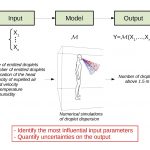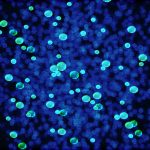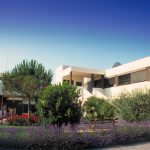December 15th, Seminar by S. Murugan
- When: Thursday, December 15th, 2022 at 10:00 (CET)
- Where: Coriolis (Galois building)
- Speaker: Sugan Murugan (ICTS, Bengalore, India)
- Topic: Galerkin-truncated solutions to the 3D incompressible Euler equation
- Abstract: Finite dimensional ideal hydrodynamical equations are known to relax to an absolute equilibrium, characterized by a Gibbsian distribution, known as thermalized fluids. We show how these thermalized fluids serve as a many-body chaotic Hamiltonian system to link foundational principles of statistical physics: thermalization and equilibriation.Using decorrelators, we derive and show that in thermalized flows λ ∝ √T, suggesting an underlying universality and providing evidence to the thermal scaling of Lyapunov exponent. On the other hand, we illustrate how Galerkin-truncated 3D incompressible Euler equations trigger the onset of thermalization in the first place. By identifying the source, how thermalization can be effectively reduced to a 1D problem similar to that of Burgers equation, then the numerical possibility of constructing weak dissipative solutions to the former.
November 25th, Seminar by S. Jara & N. Valade
- When: Friday, November 25th, 2022 at 14:00 (CET)
- Where: Coriolis (Galois building)
- Speakers:
- Sebastian Jara (University of Valparaiso, Chile)
- Nicolas Valade (Team Calisto, Inria, Sophia Antipolis)
- Topics:
- Physics Informed Neural Networks (PINN) model to characterize hemodynamic variables in the bifurcation of the pulmonary artery
- Anomalous dissipation and spontaneous stochasticity in a decaying Quasi-Geostrophic Surface flow
- Abstract:
- In this research, a physics-informed neural network (PINN) model was developed that allows predicting, from a set of scarce data, the pressure in the pulmonary artery. Incorporating the Navier-Stokes equations and a few clinical measurements in time series form for velocity and cross-sectional area of pulmonary bifurcation arteries, a 1D model of PINN was generated that allows accurate blood pressure over the entire the pulmonary artery. The clinical measurements used to feed the network are obtained from numerical models such as computational fluid simulation (CFD), and we also used four-dimensional flow magnetic resonance imaging (4D Flow MRI) performed on a healthy patient and a patient with pulmonary hypertension.
- Quasi-geostrophic surface flows (SQG) describe the two-dimensional transport of a temperature field in strongly stratified and rotated boundaries. In addition to their relevance to geophysics, the SQG equations have formal similarities to the incompressible 3D Euler equations, which give them a more fundamental interest.
In this talk, we characterize through systematic numerical simulations the deterministic emergence of a turbulence regime from a localized initial condition at large scales. In the presence of a small viscosity, the turbulent regime appears in practice in a finite time, and presents a number of the markers of isotropic homogeneous 3D turbulence. Eulerian statistics are thus characterized by the emergence of multifractal scaling laws and a dissipative anomaly. The Lagrangian statistics reveal anomalous diffusion regimes, suggesting in particular a Richardson-like explosive behavior of the trajectories. We will show that the two types of anomalies, Lagrangian and Eulerian, are in fact very strongly correlated. In particular, the unpredictability of the trajectories is a consequence of the singular and incompressible character of the velocity field.
October 20th, Seminar by E. Simonnet
- When: Thursday, October 20th, 2022 at 10:00 (CET)
- Where: Coriolis (Galois building)
- Speaker: Eric Simonnet (InPhyNi, Nice, France)
- Topic: Deep gMAM: computing nonequilibrium trajectories by a deep learning approach
- Abstract: The analysis of rare reactive events in nonequilibrium systems without detailed balance is notoriously difficult either theoretically and computationally. These examples include phase transitions, biochemical switches, atmospheric jet transitions or even climate change, and more generally whenever these systems exhibit metastability. After a brief introduction to Freidlin-Wentzell large-deviation theory, and the geometrical action method, we will show how neural networks can be used to compute general Arrhenius laws, quasi-potential estimates and nonequilibrium/instanton trajectories in a very efficient and powerful way. We will focus on two nontrivial examples.
1) First, we investigate the viscous left tail of Burgers shocks distribution in the extreme event limit. We show that neural networks are able to easily compute the corresponding instantons. They also recover the well-known 3/2 power law.
2) Second, we consider the so-called active model B (AMB) describing motility-induced phase separation. It is a nonequilibrium system with very few known results. We discuss how Neural Networks can be used to detect new scaling laws in the thermodynamical (large size) limit.
This preliminary work is a collaboration with E. Vanden Eijnden and R. Zakine (Courant Inst. USA).
June 16th, Seminar by V. Sessa
- When: Thursday, June 16th, 2022 at 10:00 (CET)
- Where: Coriolis (Galois building)
- Speaker: Valentina Sessa (Mines ParisTech – CMA, Sophia Antipolis, France)
- Topic: Analyzing the Applicability of Random Forest-Based Models for the Forecast of Run-of-River Hydropower Generation
- Abstract: Analyzing the impact of climate variables into the operational planning processes is essential for the robust implementation of a sustainable power system. This work deals with the modeling of the run-of-river hydropower production based on climate variables on the European scale. A better understanding of future run-of-river generation patterns has important implications for power systems with increasing shares of solar and wind power. Run-of-river plants are less intermittent than solar or wind, but also less dispatchable than dams with storage capacity. However, translating time series of climate data (precipitation and air temperature) into time series of run-of-river-based hydropower generation is not an easy task as it is necessary to capture the complex relationship between the availability of water and the generation of electricity. This task is also more complex when performed for a large interconnected area. In this work, a model is built for several European countries by using machine learning techniques. In particular, we compare the accuracy of models based on the Random Forest algorithm and show that a more accurate model is obtained when a finer spatial resolution of climate data is introduced. We then discuss the practical applicability of a machine learning model for the medium-term forecasts and show that some very context-specific but influential events are hard to capture.
May 19th, Seminar by G. Cordonnier
- When: Thursday, May 19th, 2022 at 10:00 (CET)
- Where: Coriolis (Galois building)
- Speaker: Guillaume Cordonnier (GraphDeco Team, Inria SAM)
- Topic: Inverse control of visual simulations with deep learning
- Abstract: The synthesis of visually plausible digital copies of the physical world is critical for several applications, including entertainment, marketing, communication, planning and training, etc. In particular, the simulation of dynamic, physically-driven natural phenomena yields several challenges: the algorithms should quickly and robustly emulate physical phenomena which are inherently complex and chaotic. Furthermore, users need to manipulate the simulations for art, business, or communication, which add a requirement: the solver should be intuitively and efficiently controllable. In this talk, I will highlight the differences and similarities between visual and physical simulations, and I will illustrate the use of machine learning to generate, accelerate, or control those simulations.
April 7th, Seminar by R. Letournel
- When: Thursday, April 7th, 2022 at 10:30 (CET)
- Where: Coriolis (Galois building)
- Speaker: Roxane Letournel (SAFRAN, Chateaufort)
- Topic: Lagrangian modeling of intermittency in turbulence
- Abstract: The characterization of intermittency in turbulence is the subject of numerous experimental, numerical and mathematical modeling studies. Stochastic processes allow to model the phenomenon from a fundamental point of view, but also to develop methods to study turbulent flows loaded with particles. Inspired by the multiplicative Gaussian chaos theory, we propose a model for the pseudo-dissipation of kinetic energy based on a sum of carefully chosen Ornstein-Uhlenbeck processes. The developed method allows to find existing processes from the literature, to derive new ones with adequate regularizations and to propose a simple and efficient numerical simulation.
March 24th, Seminar by M. Bergmann
- When: Thursday, March 24th, 2022 at 14:30 (CET)
- Where: Coriolis (Galois building)
- Speaker: Michel Bergmann (Team MEMPHIS, Inria, Bordeaux)
- Topic: Numerical simulations assisted by orthogonal eigenvalue decomposition and optimal transport
- Abstract: The numerical simulation of multiphysics problems often involves interfaces subjected to large deformations. In this context, we develop methods like Immersed Boundary which allow to get rid of conformal meshes at the interfaces. We will then show how this type of approach can be coupled with reduced models like POD (Proper Orthogonal Decomposition) and with optimal transport approaches to accelerate numerical simulations and to go towards numerical twins from experimental data. The applications presented will focus on problems of aerodynamics, bio-locomotion and bio-inspiration.
March 15th, Seminar by R. Chetrite
- When: Tuesday, March 15th, 2022 at 10:00 (CET)
- Where: Coriolis (Galois building)
- Speaker: Raphael Chetrite (Laboratoire J.A. Dieudonné, Nice)
- Topic: Homogeneization of Markovian process and application to quantum continuous measurement
- Abstract: In many physical systems, we are faced with an interaction between mechanisms that evolve at very different time scales. In this seminar, we will consider Markovian processes with such characteristics, and we will exploit the time scale separation to obtain an effective Markovian dynamics on a reduced state space. In particular, compared to existing studies, we will introduce a more general formalism. Finally, as a privileged example, we consider the limit of the strong continuous measure of quantum systems described by a Belavkin diffusive equation.





